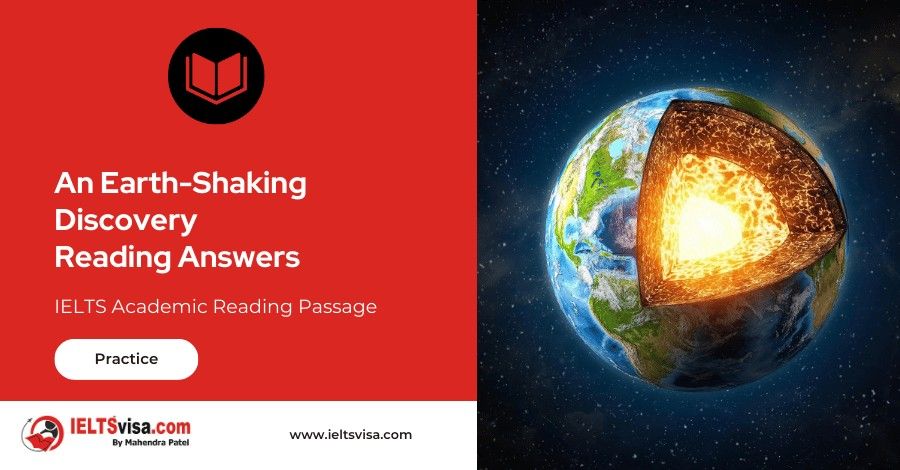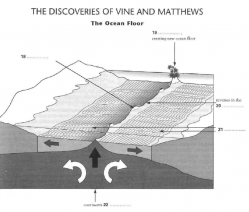An Earth-Shaking Discovery Reading Answers
IELTS Academic Reading Passage
In 1963, a paper appeared in the journal Nature that radically changed the way we view this planet and its resources. The authors, Fred Vine and Drummond Matthews, did for the Earth sciences what Crick and Watson did for biology and Einstein did for physics, and new areas of scientific development are still emerging as a result.
Yet both men are largely forgotten and unrecognised. What Vine and Matthews did was to provide proof that continents really do drift across the surface of the globe. This understanding profoundly affects the way we use the planet today – it directs the way we prospect for resources such as oil and minerals: it has enabled us to predict most volcanic eruptions and to understand patterns of earthquakes. Incredibly perhaps, an understanding of the mobile dynamic nature of the Earth is helping an understanding of long-term global climate changes. Despite the significance of their work, neither man received great honour or fame.
The idea of continental drift was first proposed in a serious way by the German meteorologist Allred Wegener in 1915. People had noticed the neat jigsaw-like fit between South America and Africa, but Wegener found actual fossil evidence that the two continents were once joined. No one took him seriously; in fact, he was ridiculed by most of the geological community. This was partly because, not being a geologist, he was perceived as an outsider. But the main reason for the hostility; according to Vine, was that Wegener was unable to come up with an explanation as to how whole continents could possibly move even an inch, let alone dance to the music of time around the globe.
In the 1920s, the Scottish geologist Arthur Holmes hypothesised that convection currents within the Earth could become sufficiently vigorous to drag the two halves of the original continent apart! In the late 1950s, an American, Harry Hess, came up with the hypothesis that new seafloor is constantly being generated at the mid-ocean ridges by hot material rising in a convection current. But neither man could find evidence to prove it. It was no more than just a hunch that it had to be right, and a hunch is not enough for science.
Vine had been fascinated by the apparent fit of the continents since the age of 14, and as a graduate student at Cambridge was assigned a project analysing one of the new magnetic surveys of the ocean floor. He found what he describes as parallel zebra swipes of normal and reversed magnetism’ around the mid-ocean ridge. Most significantly; these stripes were symmetrical either side of the ridge crests. There had to be a reason for this. The young Vine and his supervisor Matthews proposed that the magnetic stripes were caused by new ocean floor being formed as molten rock rose at the mid-ocean ridges and spread each side of the ridge.
As the molten rock solidified, it became weakly magnetised parallel to the Earth’s magnetic field. It was just becoming recognised in the early 1960s that the Earths magnetic field flips every so often, so magnetic north becomes a magnetic south pole and visa versa. These flips in the magnetic field were being recorded in the new seafloor. It was like a giant tape recording of the ocean floor’s history. As new seafloor was made, it pushed the last lot aside, widening the ocean and in turn pushing the continents either side further apart. In other words, they had discovered the mechanism driving drifting continents that were missing from Wegener’s work. The science of the Earth was never the same again.
By the end of the 1960s, confirmation of global seafloor spreading led to plate tectonics – the view of the outside of the Earth comprising just a few rigid plates which are shunted about by growing seafloor. There was a realization that mountains are formed when two plates collide, and that most volcanoes and earthquakes occur on the edges of these plates. All this was accepted as fact by all but a few diehard dinosaurs in the geological world. It is now in the impact of shifting continents on the global environment that Vine feels the most exciting and significant research lies: ‘The distribution of continents and the opening and closing of ocean gates between continents has had a profound effect on climates and has caused flips from Icehouse Earth to Green-house Earth.’
The recognition that the Earth’s hydrosphere, atmosphere and biosphere are all intimately linked with the drifting continents and the goings-on deep within the Earth has spawned the term ‘Earth Systems Science’. It is a great oak tree of science that has grown from the acorn of truth supplied by Vine and Matthews. The holistic approach of earth systems science is very much welcomed by Vine: I’m rather pleased that this has come together.’ He feels that the future for understanding the planet lies in an integrated approach to the sciences, rather than the isolated stance the geologists took throughout the 20th century: There was an incredible polarisation of science and I was caught between the boundaries. It was anathema to me – the whole of environmental science should be integrated. ’
Questions 14-17
Complete each sentence with the correct ending A-Q from the box below.
Write the correct letter A-Q in boxes 14-17 on your answer sheet.
14The work done by Vine and Matthews has had implications concerning
15Wegener attempted to explain
16Wegener’s conclusions were greeted as
17The theories presented by both Holmes and Hess concerned
Questions 18-22
Label the diagram below.
The discoveries of Vine and Matthews
The Ocean Floor

Questions 23-26
Choose NO MORE THAN THREE WORDS from the passage for each answer.
Write your answers in boxes 18-22 on your answer sheet.
Answer the questions below using NO MORE THAN THREE WORDS for each answer.
Write your answers in boxes 23-26 on your answer sheet.
23What is the name of the theory concerning the structure of the Earth that developed from the demonstration of seafloor spreading?
24According to Vine, what has the movement of continents had a big influence on?
25What branch of science has emerged as a result of the work done by Vine and Matthews?
26Which word does Vine use to describe how he believes the study of the Earth should be conducted?

Solution For: An Earth-Shaking Discovery
Reading Answers
| 14. D |
15. E |
16. B |
17. F |
|
18. Mid-ocean ridge(s)/ ridge crest(s) |
19. Molten rock rose |
20. (Earth’s) magnetic field |
21. parallel/symmetrical/magnetic (zebra) strips |
|
22. Pushed aside/(further) apart |
23. Plate tectonics |
24. climates |
25. Earth Systems Science |
|
26. integrated |
Review and Practice
- Regularly practice with IELTS reading samples and time yourself to get used to the pressure of the exam.
- Review your mistakes to understand where you went wrong and how to avoid similar errors in the future.
Our Books
Master IELTS Speaking Part 1
IELTS Writing Task 1 Book
IELTS Writing Task 2 Book
An Earth-Shaking Discovery Reading Answers Explanation
Comin Soon
Practice IELTS Other Modules
IELTS Listening
The IELTS Listening test assesses how well you can understand spoken English in various contexts. It lasts about 30 minutes and is divided into four sections with a total of 40 questions. The listening tasks become increasingly difficult as the test progresses.
IELTS Academic Reading
The IELTS Academic Reading section assesses your ability to understand and interpret a variety of texts in academic settings. It is designed to evaluate a range of reading skills, including skimming for gist, reading for main ideas, reading for detail, understanding inferences, and recognizing a writer's opinions and arguments.
IELTS Speaking
The IELTS Speaking test assesses your ability to communicate in English on everyday topics. It lasts 11-14 minutes and consists of three parts: introduction, cue card, and a discussion based on the cue card topic.
IELTS General Reading
IELTS General Reading tests your ability to understand and interpret various types of texts. Here are some key areas and types of content you can expect to encounter in the reading section, along with tips for effective preparation.
IELTS Academic Writing Task 1
In IELTS Academic Writing Task 1, you are presented with a visual representation of information, such as graphs, charts, tables, or diagrams, and you are required to summarize, compare, or explain the data in your own words.
IELTS General Writing Task 1
In IELTS General Writing Task 1, you are required to write a letter based on a given situation. The letter can be formal, semi-formal, or informal, depending on the prompt. Here’s a breakdown of the key components to include in your letter
IELTS Academic Writing Task 2
In IELTS Academic Writing Task 2, you are required to write an essay in response to a question or topic. Here’s a guide to help you understand the essential elements of this task
IELTS Exam Tips
To succeed in the IELTS exam, practice regularly, familiarize yourself with the test format, improve your vocabulary, develop time management skills, and take mock tests to build confidence.
Grammer for IELTS
Grammar is the foundation of effective communication in English. Understanding tense usage, subject-verb agreement, and sentence structure enhances clarity and coherence in writing and speaking.
Vocabulary for IELTS
Vocabulary plays a crucial role in the IELTS (International English Language Testing System) exam, especially in the Speaking and Writing sections. Here’s an overview of why vocabulary is important and how it impacts your performance
RECENT IELTS SAMPLES QUESTIONS AND ANSWERS
Walking with dinosaurs
Peter L. Falkingham and his colleagues at Manchester University are developing techniques that...
Money as the Unit of Amount Reading Answers
The most difficult aspect of money to understand is its function as a unit of account. In...
WEATHERING IN THE DESERT
In the deserts, as elsewhere, rocks at the earth's surface are changed by weathering, which...
Nature on Display in American Zoos
The first zoo in the United States opened in Philadelphia in 1874, followed by the Cincinnati...
Can We Prevent the Poles From Melting
Such is our dependence on fossil fuels, and such is the volume of carbon dioxide we have...
Air conditioning the earth reading answers
The circulation of air in the atmosphere is activated by convection, the transference of heat...













